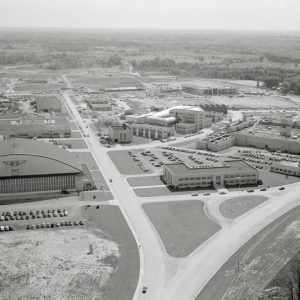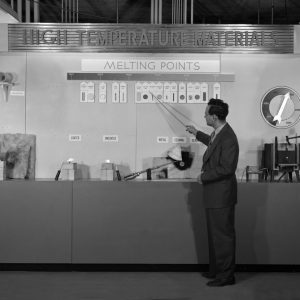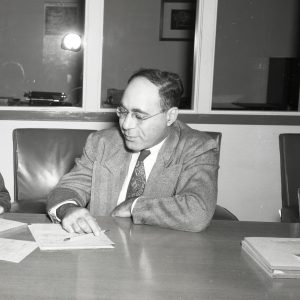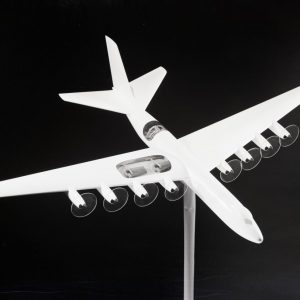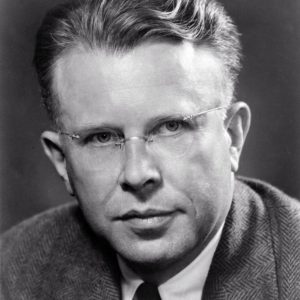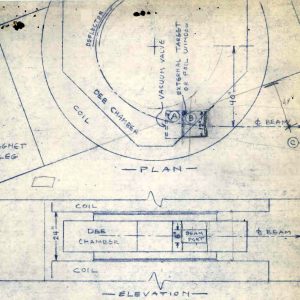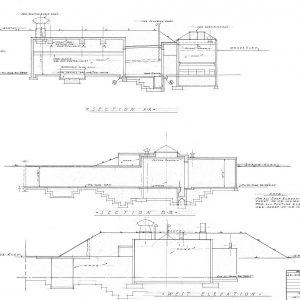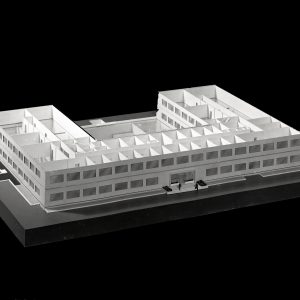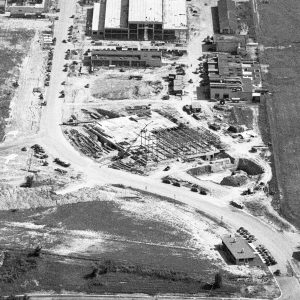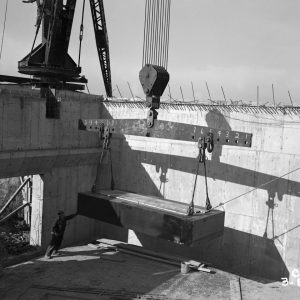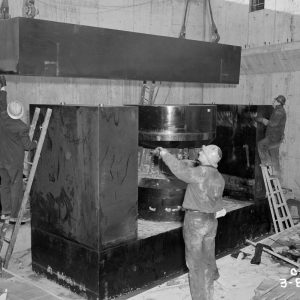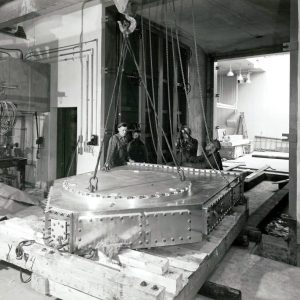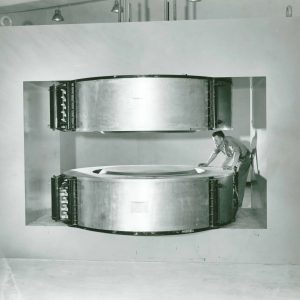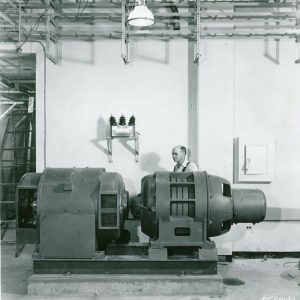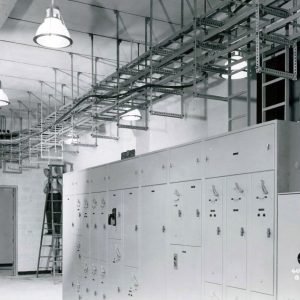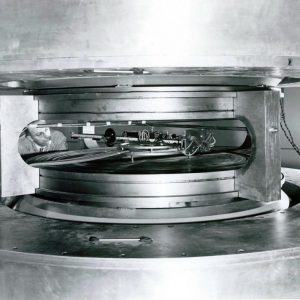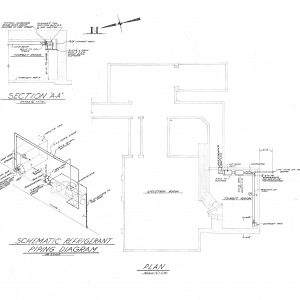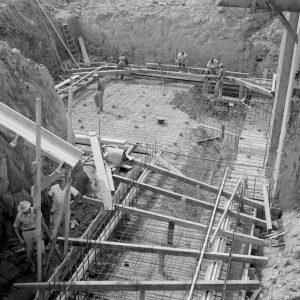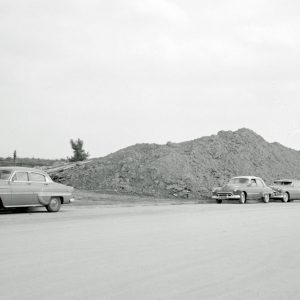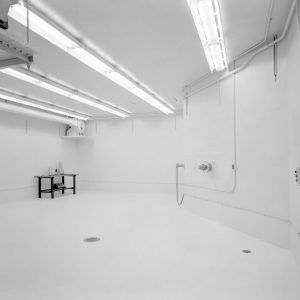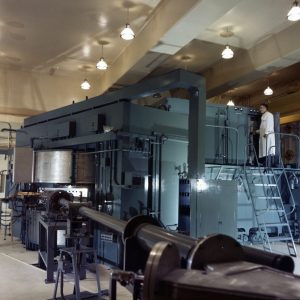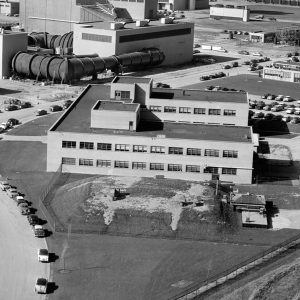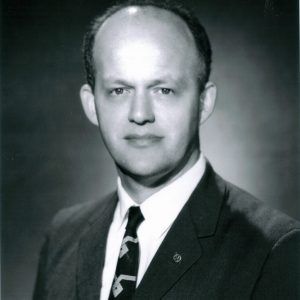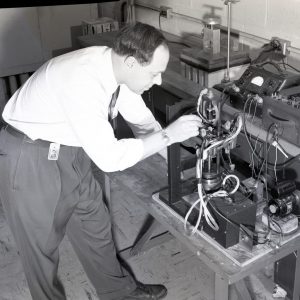Design and Construction
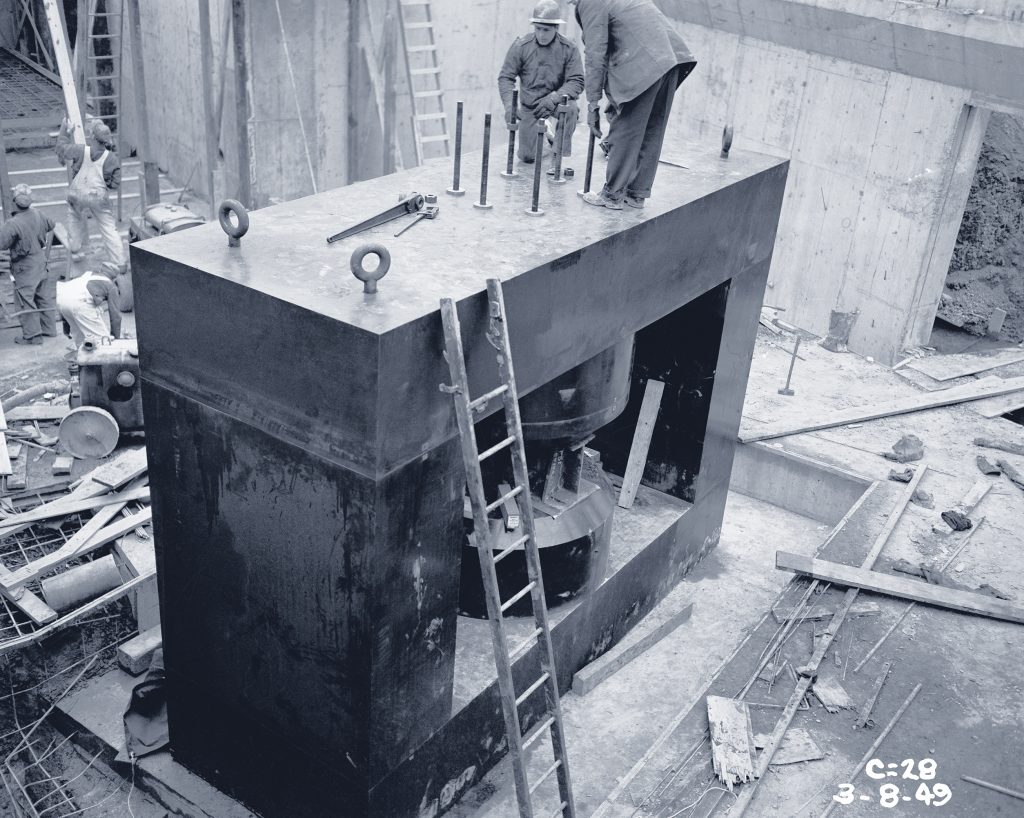
The NACA built the Cyclotron Facility in the late 1940s as part of the expansion of its materials research in support of the military’s nuclear aircraft program.
Overview
In the early 1940s, the National Advisory Committee for Aeronautics (NACA) established a laboratory in Cleveland, Ohio, dedicated to aircraft engine research. Materials research was a key component of this effort. With rising interest in nuclear-powered aircraft after World War II, it was essential to determine the effects of radiation on various materials for the engine and airframe. The NACA decided to build a particle accelerator, or cyclotron, to carry out these studies.
The NACA hired General Electric (GE) to design and build the cyclotron. The design proved challenging and required several years. Basic construction of the facility proceeded relatively smoothly, but installation of the accelerator itself proved to be a torturous process. The initial checkout testing revealed the machine did not meet the NACA’s specifications. GE added an external target room to the facility that improved the cyclotron’s capabilities. The Cyclotron began operations in 1957.
Documents
Materials Research
Congress created the NACA in 1915 to coordinate aeronautical research in the United States. In 1941, the NACA established its third research laboratory—today the Glenn Research Center, referred to as “Lewis” throughout this website—in Cleveland, Ohio, to study all elements related to aircraft propulsion systems.
One aspect analyzed lightweight materials that could withstand the high temperatures and stresses associated with engines. The Engine Performance and Materials Division studied the basic characteristics of materials that affected their performance while attempting to identify new, better-performing materials. This work often sought to increase the understanding of physics rather than attack a specific problem.
The use of nuclear weapons in August 1945 brought an end to World War II and revealed the massive power of the atom. Scientists realized this power could be harnessed for an array of civilian applications—not just destruction. The morning after the Hiroshima bombing, Lewis researchers began formulating a plan to explore atomic energy for aircraft propulsion. Although thwarted by lack of access to atomic materials, NACA researchers began analyzing high-temperature materials, studying heat transfer issues, and devising theoretical atomic aircraft and missile concepts.
The military sponsored several nuclear aircraft studies in 1946 and 1947, most significantly the Air Force’s Nuclear Energy for the Propulsion of Aircraft (NEPA) program. This required the design of a lightweight reactor and shielding to protect the crew, as well as determining the effect of radiation on materials used to construct the aircraft and engine. In August 1946, the military asked Lewis to provide technical support for NEPA.
Lewis managers realized they required their own irradiation equipment. In 1947, the laboratory proposed the construction of a cyclotron to study the effects of radiation on potential engine materials. The facility would be built in conjunction with the construction of the Materials and Stresses Building to house personnel and laboratories used to investigate materials. Five years later, Lewis requested permission to build a larger test reactor at, what is today, the Neil Armstrong Test Facility, to expand this research.
Documents
- NACA Response to the Atomic Bomb (1945)
- Materials Work for Nuclear Propulsion (1946-47)
- NACA Role for Nuclear Aircraft (1946)
- Nuclear Propulsion Inspection Talk (1954)
Design of the Cyclotron
In December 1947 the NACA requested industry bids on three different cyclotron designs, but soon settled on a 60-inch diameter unit producing a 20 mega electronvolts (MeV) deuteron beam with 0.0002 amp intensity. This was four times the output of contemporary accelerators.
On January 29, 1948, the NACA contracted with GE to construct the $715,000 ($7.9 Million, today) facility. George Dunlap, GE’s chief nucleonics designer, worked under Ernest Lawrence on the Manhattan Project. In 1945, he studied several cyclotrons before drafting plans for a GE accelerator. Although never constructed, the exercise gave the company confidence it could design and fabricate cyclotrons in-house.
Although Dunlap consulted with Lawrence and reexamined the cyclotrons at several universities, he based the NACA cyclotron on his 1945 design. During 1948, GE discovered the project required more developmental work than anticipated. Nearly 75 consultants, including a purposely non-publicized Lawrence, were brought in.
The NACA’s strict specifications for many components and the difficulty obtaining obscure materials slowed progress. Most of the design work was completed by the end of 1949, resulting in over 200 drawings.
Documents
- History of GE Cyclotron Design (1948)
- Bids Received for Cyclotron (1948)
- Cyclotron Specifications (1947)
Construction
The Cyclotron Facility and Materials and Stresses Building were constructed simultaneously. Site excavation of the site began in June 1948 and was completed by October. Reinforced concrete flooring and walls were installed over the next few months.
On March 8, 1949 the massive steel yoke which supported the accelerator was lowered into the facility. In early August, the magnets were cleaned, painted, and installed in the yoke. The exciter was mounted later in the month. The installation and checkouts continued throughout 1950.
Problems arose on many fronts. By March 1949, it became apparent that the NACA’s specifications would not produce the desired beam levels. An entire new design was needed, which was not practical. In addition, the NACA and GE disputed whether the beam should be measured inside or outside the aluminum foil window.
Finally, GE struggled to manufacture the actual cyclotron, which was to be delivered in June 1949. The delivery date continued to slip for nearly 4 years as GE worked out the issues in its plant in Schenectady, New York.
Cyclotron Becomes Operational
In spring 1954, the Lewis Cyclotron was finally ready for its first runs. It was not clear how to measure the accelerator’s performance, however. GE and the NACA negotiated throughout the year on how to settle the contract and turn over the cyclotron to Lewis. Early tests had produced just 0.00007 amps of the requested 0.0002.
GE then added a new high output ion source, an oscillator power supply, and furnace-brazed dees (hollow semicircular electrodes). The 4-day performance test runs in early March 1955 produced 0.00014 amps and 20 of the desired 40 MeV. Importantly, the density of the beam was far below the requested level.
Lewis researchers felt the cyclotron could be used, but not for its original purpose. Management, however, was displeased with the performance and pushed GE to meet the specifications. In September 1955, GE informed the NACA that the addition of focusing equipment, a vacuum, and a deflector could improve the beam intensity while increasing the overall power level.
In early 1956, GE proceeded with the effort, which included new excavation work to install a target room. Installation of the new addition and equipment was completed in late 1956. The accelerator began operation in 1957.
That year, the laboratory formed the Nuclear Reactor Division that included the Radiation Physics Branch, headed by the young engineer James W. Blue. The branch consisted of a Theoretical Physics Section and an Experimental Radiation Physics Section, which conducted most of the research in the new Cyclotron Facility. Most of the members of this branch were physicists with no previous cyclotron experience. The core was associated with the cyclotron for years.
Documents
- Possible Utilization of the Cyclotron (1955)
- Cyclotron Performance Test Results (1955)
- External Focusing Equipment Specs (1956)

